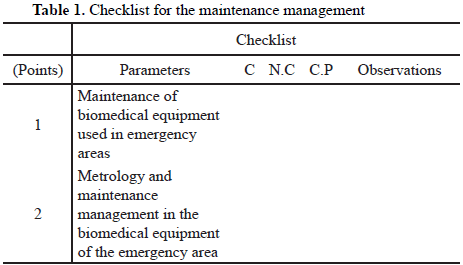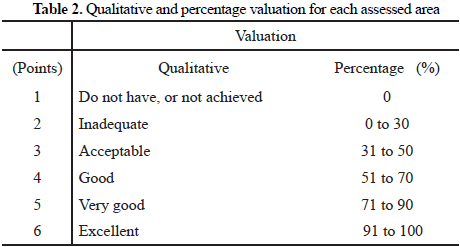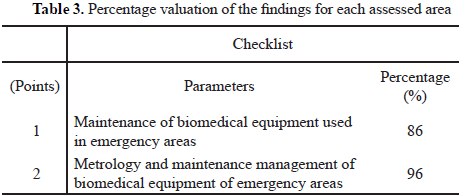Servicios Personalizados
Revista
Articulo
Indicadores
-
 Citado por SciELO
Citado por SciELO -
 Accesos
Accesos
Links relacionados
-
 Citado por Google
Citado por Google -
 Similares en
SciELO
Similares en
SciELO -
 Similares en Google
Similares en Google
Compartir
Revista Ingeniería Biomédica
versión impresa ISSN 1909-9762
Rev. ing. biomed. vol.9 no.18 Medellín jul./dic. 2015
MAINTENANCE MANAGEMENT IN BIOMEDICAL EQUIPMENTS IN THE CONTEXT OF THE RESEARCH PROJECT CLEANER PRODUCTION IN THE HEALTH CLUSTER OF MEDELLÍN, COLOMBIA
GESTIÓN DE MANTENIMIENTO DE EQUIPOS BIOMÉDICOS EN EL CONTEXTO DEL PROYECTO DE INVESTIGACIÓN DE PRODUCCIÓN MÁS LIMPIA EN EL CLUSTER DE SALUD DE MEDELLÍN, COLOMBIA
GESTÃO DE MANUTENÇÃO DE EQUIPAMENTOS BIOMÉDICOS NO CONTEXTO DO PROJETO DE PESQUISA PRODUÇÃO MAIS LIMPA NO CLUSTER DE SAÚDE DE MEDELLIN, COLÔMBIA
W. Orozco1, G. Narváez2, L. F Galvis3, D. M. Cano3
1 Research Group in Maintenance and Materials IDEGMA. Faculty of Engineering, Institución Universitaria Pascual Bravo. Medellín, Colombia.
Dirección para correspondencia: william.orozco@pascualbravo.edu.co.
2 Research Group ALQUIMIA. Faculty of Exact and Applied Sciences, Instituto Tecnológico Metropolitano. Medellín, Colombia.
3 Research and Biomedical Innovation Group GI2B. Faculty of Exact and Applied Sciences, Instituto Tecnológico Metropolitano. Medellín, Colombia.
ABSTRACT
Objective: Characterize the state of the maintenance management of biomedical equipment in the emergency area of a (1) third-level hospital of high complexity medical assistance of the city of Medellin, Colombia in the period 2013-2014, within the Cleaner Production in Health research project. Methodology: A survey from the Cleaner Production Sectorial Guide in Hospitals, Clinics and Health Centers was designed; where a checklist, for the initial review of the maintenance management of the most complex biomedical equipment used in emergency areas was obtained. Results: In the surveyed institutions, it was found that the maintenance of the biomedical equipment, used in emergency areas, obtained a percentage of 86%, whilst in the metrology and maintenance management in the biomedical equipment, used in emergency areas, obtained a percentage of 96%. Conclusion: In the health institution, an appropriate maintenance management and an excellent metrological control to the emergency equipment (vital signs monitors, defibrillators, blood pressure monitors, servo-control incubators, electrocardiographs, and mechanical ventilators) is done. This indicates that only corrective maintenance of the equipment will be required when programmed.
KEYWORDS: Biomedical equipment; Maintenance management; Hospitals; Biomedical metrology; Cleaner production.
RESUMEN
Objetivo: Caracterizar el estado de la gestión de mantenimiento de equipos biomédicos en el área de urgencias de un (1) hospital de tercer nivel de asistencia médica de alta complejidad de la ciudad de Medellín, Colombia en el período 2013-2014, dentro del proyecto de investigación Guía Sectorial de Producción más Limpia en Hospitales. Metodología: Se diseñó una encuesta de la Guía Sectorial de Producción más Limpia en Hospitales, Clínicas y Centros de Salud; donde se obtuvo una lista de control, para la revisión inicial de la gestión de mantenimiento de los más complejos equipos biomédicos utilizados en zonas de emergencia. Resultados: En las instituciones encuestadas se encontró que el mantenimiento del equipo biomédico, que se utiliza en las zonas de emergencia, obtiene un porcentaje del 86%, mientras que en la gestión de metrología y mantenimiento en el equipo biomédico, que se utiliza en las zonas de emergencia, obtuvo un porcentaje de 96%. Conclusión: En la institución de salud se realiza una gestión adecuada de mantenimiento y un excelente control metrológico de los equipos de emergencia (monitores de signos vitales, desfibriladores, monitores de presión arterial, incubadoras de control de servo, electrocardiógrafos y ventiladores mecánicos). Esto indica que sólo se requerirá el mantenimiento correctivo de los equipos cuando fuera programado.
PALABRAS CLAVE: Detección de movimiento, Electrofisiología, Modelos, Ondas, Estados locales y globales.
RESUMO
Objetivo: Caracterizar o estado da gestão de manutenção de equipamentos biomédicos no departamento de emergência de um (1) hospital terciário de assistência de saúde de alta complexidade na cidade de Medellín, Colômbia, em 2013-2014, no âmbito do projeto de investigação guia de setores de Produção Mais Limpa em hospitais. Metodologia: foi realizada uma pesquisa da Guia de Setores de Produção Mais Limpa em Hospitais, clinicas e Centros de Saúde; onde obteve uma lista de verificação para avaliação inicial da gestão da manutenção dos equipamentos biomédicos mais complexa utilizada em zonas de emergência. Resultados: Nas instituições pesquisadas verificou se que a manutenção de equipamentos biomédicos, utilizado nas zonas de emergência, recebe uma porcentagem do 86%, enquanto a gestão de metrologia e manutenção nos equipamentos biomédicos, usado nas áreas de emergência, obteve uma percentagem de 96%. Conclusão: Na instituição de saúde se realiza uma adequada gestão de manutenção e excelente controle metrológico dos equipamentos de emergência (monitores de sinais vitais, desfibriladores, monitores de pressão arterial, incubadoras de controle de servo, eletrocardiógrafos e ventiladores mecânicos). Isso indica que apenas é necessária a manutenção corretiva dos equipamentos quando seja agendada.
PALAVRAS-CHAVE: Equipamentos biomédicos; Gestão de manutenção; Hospitais; Metrologia biomédica; Produção mais limpa.
I. INTRODUCTION
Maintenance management is a tool to support the medical and engineering staff in the development, control, and direction of maintenance programs in order to contribute to the improvement of the biomedical practices at an effective cost in the installed technology [1].
Maintenance management of biomedical equipment becomes increasingly important in the world because of the growing demand for hospital services, to the high cost of technology, and its constant growth and evolution [2], to the need to improve processes in order to be more competitive, and for the improvement of quality processes of high, medium, and low technological equipment; besides, to increase the safety of the patient and the user of the equipment [3].
The cleaner production from work processes is one of the most recently applied methodologies in the institutional health service providers both public and private [4], to generate technological development and innovation of goods and services. These methodologies involve the reduction of impacts on the environment, minimizing the health risks of workers, and the reduction of costs incurred in the production of waste and atmospheric emissions [5]. Consequently, cleaner production is set to become the goal to be achieved through new investments, while the systematic search for continuous improvement will allow it to be a dynamic and systematic process, which is not applied once, but permanently in each of the phases of the life cycle of the product, or in the provision of services [6].
In view of the above, this paper presents the principal data and conclusions obtained in the research project on cleaner production in health, applied to the maintenance management of the biomedical equipment used in the emergency areas for adults and pediatrics at a health institution of Medellin, Colombia.
The Project which is the subject matter of this paper was led by professor William Orozco M, who is an active member of the IDEGMA and GI2B research groups, assigned to the Institución Universitaria Pascual Bravo (IUPB), and the Instituto Tecnológico Metropolitano (ITM), respectively; in company of two students from the last semester of the technology in maintenance of biomedical equipment who belong to GI2B research group, in coordination with professor Gonzalo Narváez Benjumea, principal investigator and member of the Basic Chemistry, Applied and Environment-ALQUIMIA research group from Instituto Tecnológico Metropolitano of Medellin, Colombia.
II. METHODOLOGY
A survey from the Cleaner Production Sectorial Guide in hospitals, clinics and health centers was designed [4], where a checklist, for the initial review of the maintenance management of the most complex biomedical equipment used in emergency areas, was obtained. Table 1. To this end, the survey was divided into two areas: maintenance of biomedical equipment used in the emergency areas with 14 questions aimed at determining the existence of maintenance protocols, types of maintenance used, personnel involved in the maintenance, and the life data sheets of the equipment.
And, metrology and maintenance management of the emergency biomedical equipment with 12 questions aimed at determining the relation between the calibration of equipment and their maintenance, the entity performing the calibration of the equipment, the personnel in charge of the maintenance management, the budget plan for the maintenance, and the certification and accreditation plans of the health institution [7].
Each question is given a rating based on the following findings: Table 1.
C: Fully Compliant (10 points)
N.C: Non-Compliant (0 points)
C.P: Partially Compliant (5 points)
Finally, observations according to the strengths (F), opportunities for improvement (O.M) and recommendations (R) are made; thus obtaining a qualitative and percentage valuation for each assessed area, as shown in Table 2.
III. RESULTS
From the analysis of the findings identified in the initial review of the conditions of the maintenance management of biomedical equipment in the emergency area, it was found that:
Maintenance management of the biomedical equipment used in the emergency area in this institution is very good, with a rating of 86%. Value obtained from Table 2 and instructive analysis applied to some groups of high-risk equipment (vital signs monitors, defibrillators, blood pressure monitors, servo-control incubators, electrocardiographs, and mechanical ventilators) from the emergency service; Table 3.
Metrology and maintenance management of biomedical equipment of emergency areas is excellent, with a rating of 96%. Value obtained from Table 2 and applied to the instructional analysis equipment group mentioned above, Table 3.
The above shows that, an appropriate maintenance management of the biomedical equipment is carried out in this health institution. This indicates that only corrective maintenance of the equipment will be required when programmed, significantly reducing the emergency stops, the spare parts and materials, the supplies, and all the other elements used in the repairs, therefore, contaminants and residues generated in this activity are reduced; thus helping the cleaner production of the institution [8, 9].
IV. DISCUSSION
Considering resolution 1441 of 2013 from the Ministry of Health and Social Protection [7], which defines the procedures and conditions to be met by the Health Services Provider Institutions in order to enable the services, it was found that the emergency area of the surveyed institution is fitted with the groups of highrisk equipment necessary to provide the service, the maintenance management of the most complex biomedical equipment is very good, and metrology and management of biomedical equipment maintenance in the emergency area are excellent, as shown in tables II and III.
Nevertheless, it is necessary that the health institution improve some aspects, to achieve effectiveness at 100% in the maintenance management of the high risk biomedical equipment used in the emergency areas, such as: designing calibration procedures in order to guarantee the optimization of protocols established in the metrology laboratory, availability from the metrology laboratory to provide an induction or training to ensure the adaptation of the practitioners at the hospital; more efficient processes in the maintenance area of the hospital in relation to the demand for compliance with the schedules of the established maintenance to the external suppliers of the equipment under warranty [10], as well as more efficiency in the supply of spare parts required by the equipment from these providers; since these providers are the people responsible for the handling of the equipment when they are in warranty [11], if this aspect is improved, the functioning time of such equipment in the area will be optimized; lastly, it is important to standardize the hospital logo in the various documents used for maintenance management, especially in work orders.
Maintenance management is a scientifically based methodology, in which the use of existing tools is optimized, as well as the execution time of the work that the operators carry out, in order to ensure that the different equipment of medical help receive the required maintenance, and at the right moment [12].
This will allow to have a better performance of the biomedical equipment, which will lead to increase the quality of the service [13].
As shown in the percentage valuation results of the findings for each assessed area in maintenance of the biomedical equipment used in emergency areas; and the metrology and maintenance management of the biomedical equipment; it is necessary to improve some aspects in order to properly channel them to provide a good health service at a reasonable cost [14].
The global language of public health requires standards for monitoring and greater transparency in the provision of health services, in such a way as to allow winning the trust of users, and improving the image and the characterization of the maintenance management of the biomedical equipment in emergency services in health institutions, which will generate a sense of security in the population of interest [15].
Facing the managerial implications, health Institutions need to be aware of the importance of developing a set of tools and activities that lead to monitor the quality of services provided to the institutions by maintenance providers, both external and internal; tools that can be obtained if an adequate maintenance management in the different special attention areas in hospitals and clinics is made [16].
V. CONCLUSIONS
An appropriate maintenance management and an excellent metrological control of the biomedical equipment are carried out in this health institution. This indicates that only corrective maintenance of the equipment will be required when programmed, significantly reducing the emergency stops, the spare parts and materials, the supplies, and all the other elements used in the repairs, therefore, contaminants and residues generated in this activity are reduced; thus helping the cleaner production of the institution.
Metrology and management of equipment maintenance is an area that needs to be strengthened in different health institutions, since, in this moment, it is one of the greatest needs that we have in the health sector.
Finally, it is necessary that the institutions of higher education, which have biomedical programs, carry out diagnosis activities in the different health institutions, aiming at training suitable professionals based on the needs and weaknesses found in the area.
ACKNOWLEDGEMENTS
The authors thank the health institution for its voluntary participation in the project, the head of maintenance and the technologists who answered the questions from the guide, the Research and Biomedical Innovation Group GI2B, the Research Group in Maintenance and Materials IDEGMA. Also, the operational management of research at Institución Universitaria Pascual Bravo (IUPB), the research department of the Instituto Tecnológico Metropolitano (ITM), the Colombian Association of Sanitary and Environmental Engineering (ACODAL North West), the Management and Environmental Services S.A.S (GSA), and the ARP-COLMENA.
REFERENCES
[1]. Rodríguez E., Sánchez M.C., Miguel A. Gestión de mantenimiento para equipos médicos. Ingeniería electrónica, Automática y Comunicaciones, Mayo 23 de 2001. [ Links ]
[2]. Temple C., Kaur M., Lenel A., Kawohl W. How to Organize the Maintenance of Your Healthcare Technology. 'How to Manage' Series for Healthcare Technology Guide 5, 1 (5), 1-299, 2005. [ Links ]
[3]. Carnero M. Simulation of trends of maintenance policies. A case study in a Hospital. 7th WSEAS Int. Conf. on applied computer & applied computational science (ACACOS '08), Hangzhou, China April 6-8, 2008. [ Links ]
[4]. Centro Nacional de Producción Más Limpia y Tecnologías Ambientales. Guía Sectorial de Producción más Limpia, hospitales, clínicas y centros de salud. Consultado el 11 de junio de 2014 en: http://www.cnpml.org/templates/panalVerde/images/publicaciones.GuiaSectorialDePMLEnHospitalesClinicasyCentrosDeSalud.pdf. [ Links ]
[5]. Secretaría de Ambiente de Bogotá. Importancia de la Producción Más Limpia en IPS. Consultado el 25 de septiembre de 2011 en: http://acercar.ambientebogota.gov.co/industria/biblioteca/MANUAL-DE-BUENAS-PRACTICAS/MANUAL%20SECTOR%20IPS/capitulo1.%20Importancia%20de%20la%20Producci%C3%B3n%20mas%20limpia%20en%20IPS.pdf. [ Links ]
[6]. Herrera C.M. La evolución y el futuro de la producción más limpia en Colombia. 2011. Consultado el 25 de septiembre de 2011 en: http://revistaing.uniandes.edu.co/pdf/26a12.pdf. [ Links ]
[7]. Minprotecciónsocial. Resolución 1441, procedimientos y condiciones que debe cumplir los Prestadores de Servicio de Salud para habilitar los servicios. Santa Fe de Bogotá: Supersalud 2014. [ Links ]
[8]. Orozco W. Tendencias actuales de la gestión de mantenimiento hospitalario e industrial. Medellín: ITPB, 2002, p. 133. [ Links ]
[9]. Martínez W. Gerencia del mantenimiento en hospitales. Maintenance Management Healthcare Administration. Honolulu, Hawai: Atlantic International University, septiembre 2009, p 7. [ Links ]
[10]. Cruz A.M., S. Usaquén, Vanegas N., Lopera C. Aplicación de técnicas de clustering para caracterizar proveedores de servicios de mantenimiento. Revista Salud Pública, 12(3), 464-473, 2010. [ Links ]
[11]. Orozco W., Cardona E. Cartilla técnica del desfibrilador. Medellín: ITM; 2008. [ Links ]
[12]. Vásquez C., Pérez M. Guía para la implementación del Programa Nacional de Tecnovigilancia en el Hospital General de Medellín. Revista Ingeniería Biomédica, 5(9), 60-78, 2011. [ Links ]
[13]. Orozco W. Tendencias actuales de la gestión de mantenimiento hospitalario e industrial. Medellín: ITM, 2007, p. 239. [ Links ]
[14]. Cruz A.M., Aguilera W.A, D.A Días. A comparative study of maintenance services using the data-mining technique. Rev Salud Pública, 11(4), 653-61. Aug 2010b. [ Links ]
[15]. Muñoz A. Gestión de mantenimiento en la Clínica el Prado Santa Marta, Colombia. Santiago de Cali: Universidad Autónoma de Occidente, 2008, p. 105. [ Links ]
[16]. Orozco W., Cortés F. Caracterización de la gestión del mantenimiento de equipo biomédico en servicios de urgencia de clínicas y hospitales de Medellín en el período 2008-2009. Rev Cienc Salud, 11(1), 35-44, 2013. [ Links ]
















